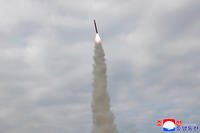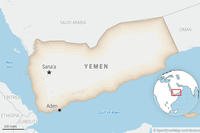NATIONAL HARBOR, Md. -- The German air defense frigate Hessen, the only warship in a Western fleet with three types of anti-air missiles, will deploy from Naval Station Norfolk, Virginia, on Wednesday with the carrier Harry S. Truman strike group in an effort to boost joint operations of NATO-allied navies.
The Hessen and the Royal Norwegian Navy frigate Roald Amundsen arrived in Norfolk in January to join sea training with the Truman.
Only the Hessen will be part of the carrier strike group, which also consists of the guided-missile destroyers Arleigh Burke, Bulkeley, Sherman and Farragut, for a deployment to the 5th and 6th Fleets areas of operations.
When the Hessen arrived in Norfolk, the ship's commanding officer, Cmdr. Oliver Pfennig, said in a statement, "The integration of German warship Hessen in the carrier strike group requires a lot of trust in our capabilities, and we will perform professionally and competently in all upcoming operations."
Last year, the Danish frigate Peter Willemoes joined the George H.W. Bush carrier strike group while in the Mediterranean.
It is unclear how long the Hessen will remain with the Truman strike group, but Vice Adm. Andreas Krause, chief of the German Navy, said Monday that the frigate's deployment is a sign that the state of the Bundeswehr, or German armed forces, is not as bad as depicted in a devastating report from Germany's parliament in February.
In his annual report, Hans-Peter Bartels, the German Parliament's armed forces commissioner, found that the state of the Bundeswehr's equipment -- from submarines and helicopters to Leopard tanks and body armor -- was "dramatically bad."
"At the end of the year, six out of six submarines were not in use. At times, not one of the 14 Airbus A400M [transport aircraft] could fly," Bartels said in the report, citing chronic underfunding and poor management.
In addition, only 95 of 244 Leopard 2 battle tanks were found to be combat ready, the report said.
Krause cited the report in his remarks during a panel discussion with the chiefs of the Spanish and Swedish navies Monday at the Sea-Air-Space 2018 exposition at the Gaylord National Convention Center at National Harbor, Maryland.
"Helicopters that do not fly, the entire submarine fleet down and the delivery of new frigates significantly delayed," he said, citing the report.
The report's findings were "factually correct," said Krause, a submariner and former commander of the U-22, but "they are at the same time suited to create a misleading impression, as they were only accurate for a very short, limited time."
Last week, Germany had 19 ships deployed, he said, and the government is committed to boosting military funding, although it is expected to be years away from meeting the Trump administration's demands for all NATO members to spend at least two percent of gross domestic product on defense.
In the panel discussion, Krause; Adm. Teodoro López Calderón, chief of the Spanish Navy; and Rear Adm. Jens Nykvist, head of Swedish Navy, all stressed the importance of interoperability and partnership among allied navies to meet the growing threats from Russia and China.
Rear Adm. Francis Morley, director of the U.S. Navy's International Programs Office who led the panel discussion, said NATO is up against a "resurgent great power global environment and competition."
He said, "We cannot hope to be successful in this growing great power competitive strategic environment without exercising fully our common advantage of partnership."
-- Richard Sisk can be reached at Richard.Sisk@Military.com.














